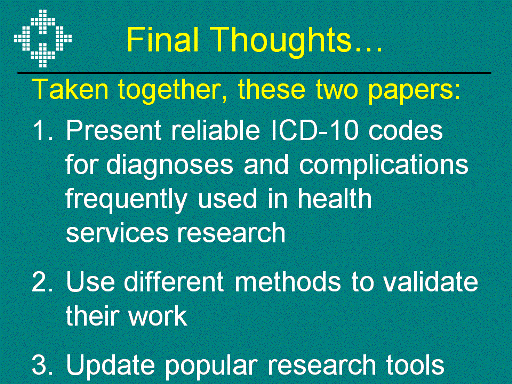| front |1 |2 |3 |4 |5 |6 |7 |8 |9 |10 |11 |12 |13 |14 |15 |16 |17 |18 |19 |20 |21 |22 |23 |24 |25 |26 |27 |28 |29 |30 |review |
 |
Reference List:
Burchill, C., L. L. Roos, P. Fergusson, L. Jebamani, K. Turner and S. Dueck. Organizing the Present, Looking to the Future: An Online Knowledge Repository to Facilitate Collaboration. Journal of Medical Internet Research. 2000;2(2):e10.[abstract]
Deyo RA, Cherkin DC, Ciol MA. Adapting a clinical comorbidity index for use with ICD-9-CM administrative data: differing perspectives. J Clin Epidemiol. 1993;46(10):1075-1079
Halfon P, Eggli Y, van Melle G, Chevalier J, Wasserfallen JB, and Burnand B. Measuring potentially avoidable hospital readmissions. Journal of Clinical Epidemiology. 2002;55(6):573-587. [abstract]
Kokotailo RA, Hill MD. Coding of Stroke and Stroke Risk Factors Using International Classification of Disease, Revisions 9 and 10. Stroke 2005; 36(8):1776-81.[abstract]
Roos L, Soodeen RA, Bond R, Burchill C. Working More Productively: Tools for Administrative Data. Health Services Research. 2003;38(5):1339-1357. [abstract]
Sundararajan V, Henderson T, Perry C, et al. New ICD-10 version of the Charlson comorbidity index predicts in hospital mortality. Journal of Clinical Epidemiology. 2004;57(12):1288-1294. [abstract]
Quan H, Sundararajan V, Halfon P, Fong A, Burnand B, Luthi JC, Saunders LD, Beck CA, Feasby TE , and Ghali WA. Coding algorithms for defining comorbidities in ICD-9-CM and ICD-10 administrative data. Med Care. 2005;43(11):1130-1139. [abstract]
|